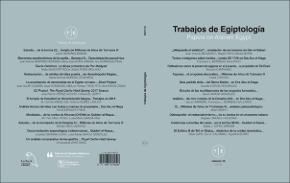El Edificio B de Tell el-Ghaba como un caso de estudio para repensar la dinámica de la unidad doméstica en el Egipto antiguo
Fecha
2019Resumen
Tell el-Ghaba, localizado en el extremo oriental del Delta y cercano al extinto brazo Pelusíaco, es un asentamiento de comienzos del Tercer Periodo Intermedio y periodo Saíta temprano. Los contextos cerámicos y otros hallazgos recuperados en el Edificio B del Área I (nivel IV) nos permiten inferir la relación de sus residentes con los artefactos que ellos manipulaban cotidianamente. Proponemos la idea de “multifuncionalidad” en el uso de los espacios residenciales, a partir de la presencia de contextos que apuntan al desarrollo de una variedad de actividades. El uso de las habitaciones estuvo ligado íntimamente a factores sociales internos así como a la relación existente con el espacio exterior, ambos planificados de acuerdo a ciertas expectativas, también sociales. Este edificio habría sido residencia de una familia extensa por varias generaciones, como lo demuestran las restauraciones evidenciadas en el mismo. El conjunto cerámico ha estado asociado principalmente a actividades de almacenamiento, consumo y preparación de alimentos, conservación y transporte de sustancias líquidas y sólidas. A partir de estas actividades y la relación de los residentes del Edificio B con la materialidad con la cual interactuaban cotidianamente, buscamos interpretar la dinámica social y económica que se habría establecido en esta unidad doméstica. Tell el-Ghaba, located at the Egyptian Eastern border of the Nile Delta and close to the extinct Pelusiac branch of the Nile, is a settlement dated to the beginning of the Third Intermediate-early Saite periods. The pottery contexts and other finds recovered in Building B (Area I, Level IV) allow us to infer the relationship established between their residents and the domestic artifacts they handled on a daily basis. The idea of ‘multifunctionality’ is applied to the use of residential spaces, based on the presence of domestic contexts that point to the performance of a variety of activities. The activities within the room were intimately linked to internal social factors as well as to the relationship with outdoor space, both planned according to certain social expectations. This building would have been the residence of an extended family for several generations, as evidenced by several refurbishments. The ceramic group has been mainly associated with storage activities, consumption and preparation of food, conservation, and transport of liquid and solid substances. From these activities and the relationship of Building B’s inhabitants with the materiality with which they interacted on a daily basis, the social and economic dynamics that would have been established in this household is analysed.





